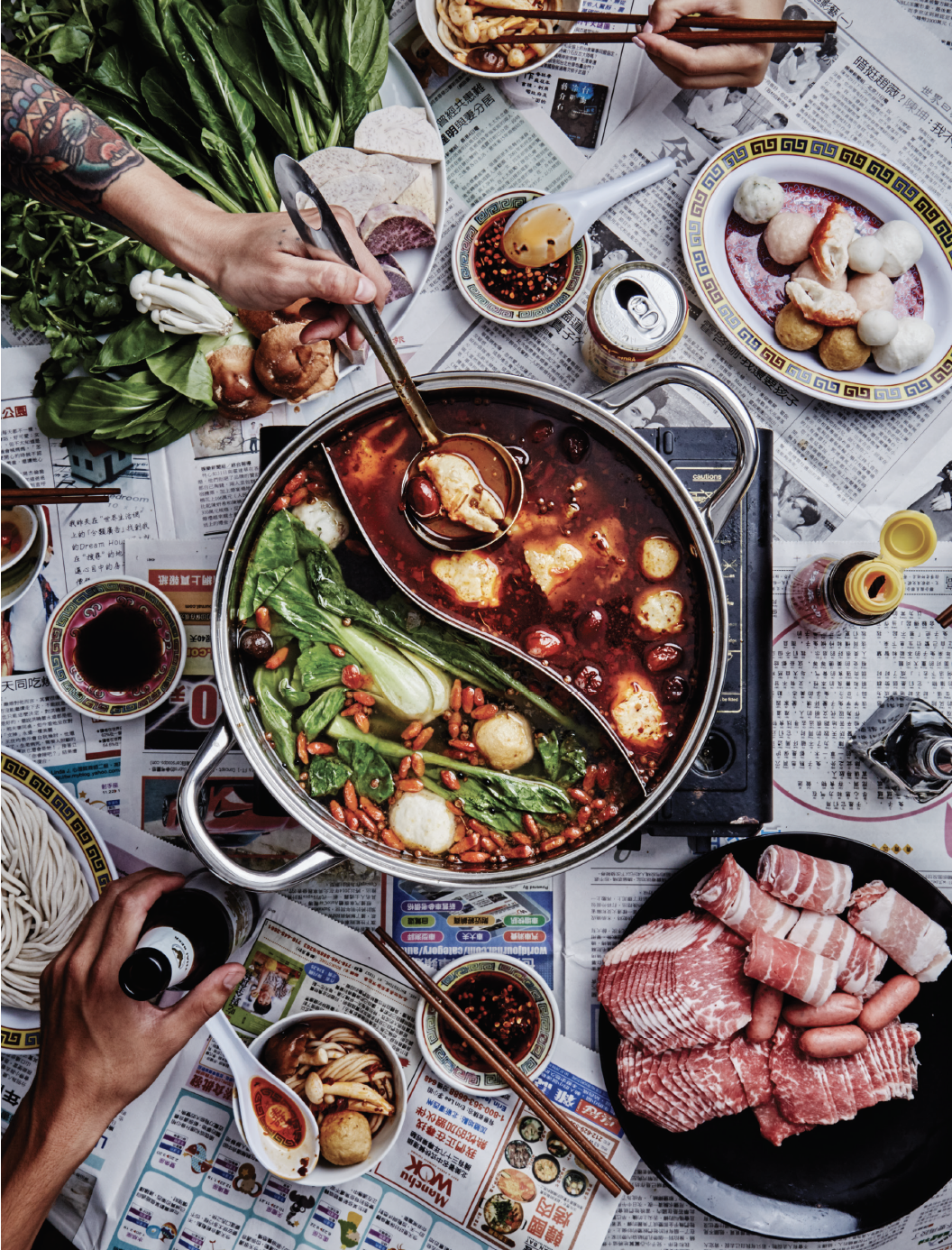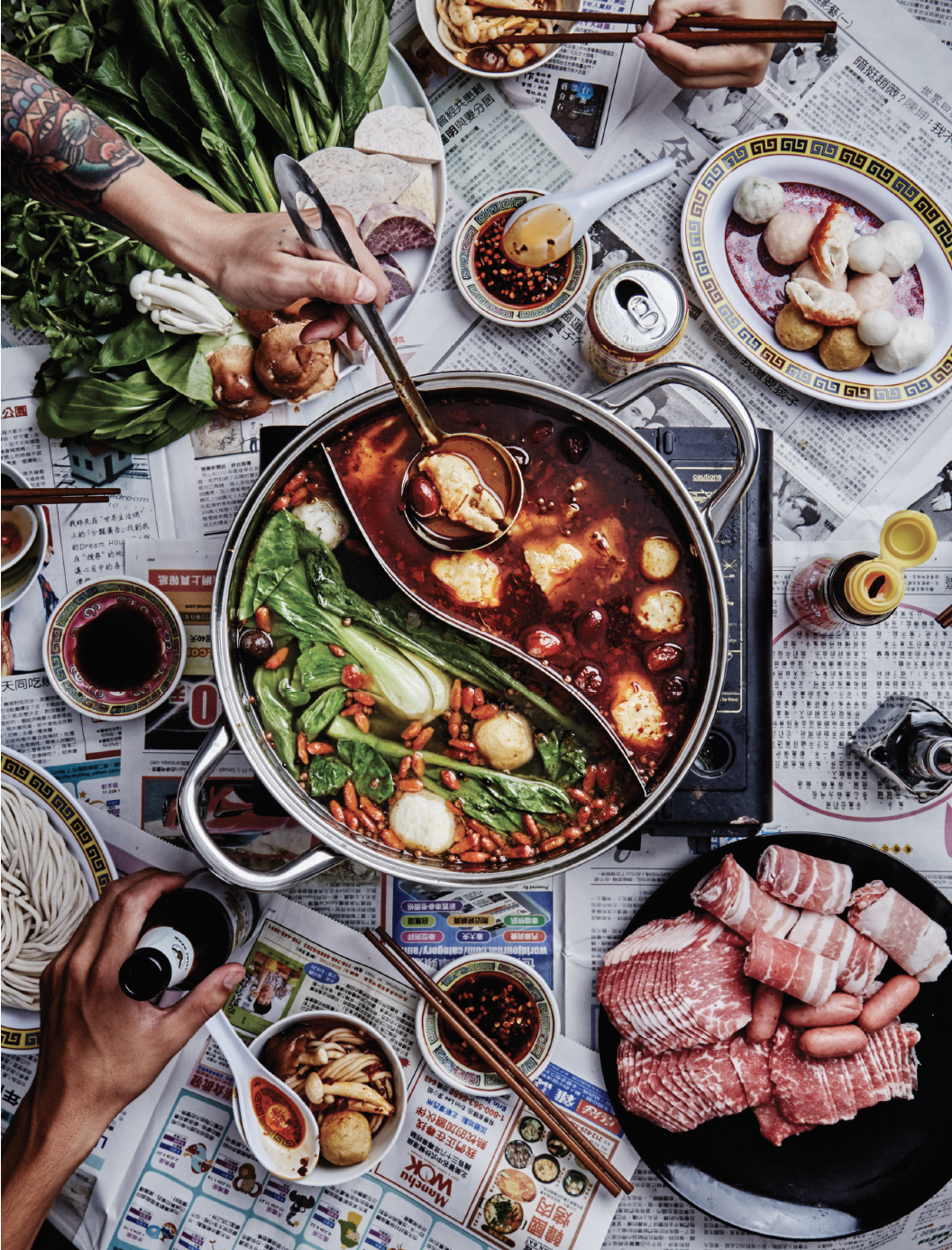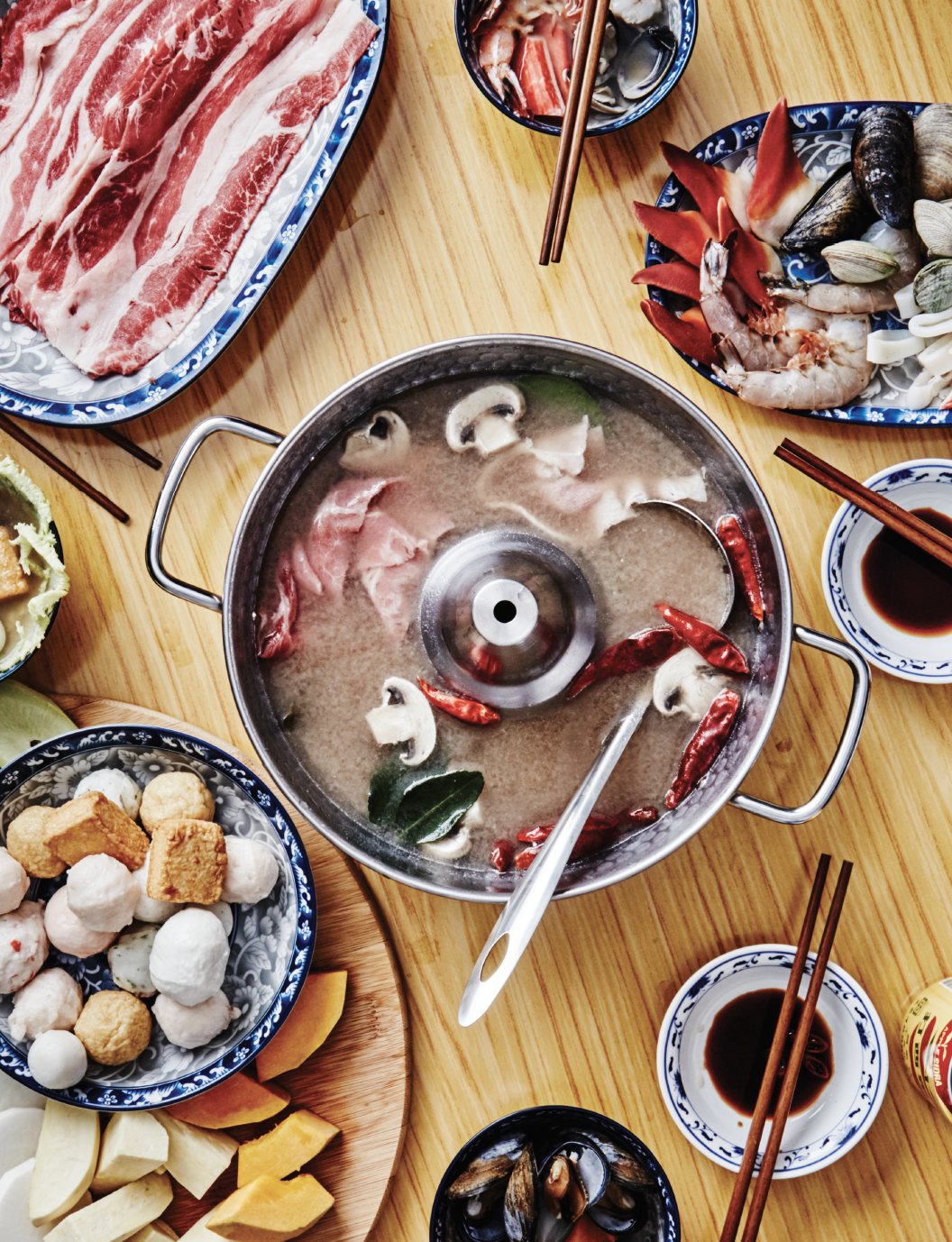Hot Pot, Three Ways
Hot Pot, Three Ways
(From the Banana Archives: Issue 003)
Words: Eric Diep
Photos: Alex Lau Food
Styling + Recipes: Tyna Hoang
When the weather gets gray and dreary, we yearn for comfort foods that warm the body and soul. Chinese hot pot (huǒ guō), also known as Chinese fondue, has a long history of combating wintery nights, and its popularity across North America has encouraged people to host hot pot feasts at home. The experience is communal dining in its purest form: you assemble your mise en place—that is, an array of meats, seafood, leafy vegetables, and starches—and gather around a simmering pot of broth of your choice with dipping sauces.
“Hot pot is really about being able to customize what you want in the meal, from choosing raw ingredients to how you build your dipping sauce,” says food stylist, Tyna Hoang. “Even the doneness of your meats and veggies are in your control. It’s the perfect meal for a picky eater or even a control freak. Not to mention, interactive eating is so much more fun.”
There are three essential types—Chinese, Japanese, and Thai—that are foundations for a ton of iteration. “I choose Sichuan in particular because of the bold flavors and because of the uniqueness of the split broth option,” Hoang says of the recipes she’s highlighted for Banana. “Japanese hot pot is much more refined. The broth is simple and clean to highlight the quality of the meats and vegetables. Thai style is exotic in broth flavors, blending sweet, spicy and savory.”
A common dish in China, hot pot has evolved with other variations in Korea, Japan, Vietnam and Thailand that satisfy any mood. Hotpotting is typically enjoyed during Lunar New Year, or simply for a fulfilling meal to share with family and friends. The attraction of hot pot lies in its simplicity, and the idea of cooking for yourself; swashing raw meat in a spicy Hong Tang style hot pot with Sichuan peppercorns will have your mouth delightfully numb.
Though your ingredients can be personalized, Hoang says you’ll normally find proteins, greens and root vegetables in just about every style. Chinese hot pot will always be paired with thinly sliced steak and pork; Japanese style is tasty with Wagyu beef; Thai broths almost always feature a variety of seafood like fish balls, mussels, and squid. Vegetables across all three styles are not limited to bok choy, mushrooms and napa cabbage. When it comes to noodles, Chinese hot pot often pairs with hand-pulled or flour noodles, Thai varieties customarily use egg or cellophane noodles; and Japanese generally goes with soba, udon, or fresh ramen.
Soup base flavors, are native to the country: Thai suki is a chicken broth with dried chilies, while milder versions like the Japanese shabu-shabu use kelp seaweed. “Thai is similar to Chinese with soy but heavier on spices such as crushed peppers, sliced chili, lime juice, fish sauce, and garlic,” Hoang says. The literal translation of shabu-shabu is “squish squish,” she adds, “mimicking the sound and movement that is made when dripping thin slices of meats or veggies in the broth.”
Here, Banana takes a closer look at three recipes, created by Hoang, that you can try for yourself: mild Qing Tang and spicy Hong Tang versions of Sichuan hot pot in the “yin-yang” split style, Japanese shabu-shabu and Thai suki which is originally derived from Chinese hot pot.
Sichuan
Hong Tang Spicy Broth
2 tbsp. oil
3 slices ginger
3 bay leaves
5 cloves garlic, peeled
3 star anise
5 cloves
1 tbsp. Sichuan peppercorns
10 dried dates
10 whole dried red chilies
1 package spicy hot pot soup base
6 cups chicken stock
1. In a pan over medium heat, add oil and ginger and cook for about a minute.
2. Add bay leaves, garlic, star anise, cloves and cook for another two minutes until fragrant.
3. Add peppercorns, dried chilies and soup base.
4. Cook for a few minutes and then add the chicken stop and bring to a boil.
Qing Tang
Stock
Chicken carcass
1 lb pork bones
3 slices ginger
2 scallions
Soup
1 tbsp. goji berries
5 dried dates
1 dried shittake mushroom
2 tbsp. cooking wine
2 scallions Salt and pepper
Dipping Sauce
Soy sauce
Sacha sauce
Chili oil Black vinegar
Rice vinegar
Sesame oil
Minced garlic
Scallions
Egg yolk
1. Make stock: boil chicken carcass and pork bones in a pot of water until the color of meat turns white.
2. Strain and rinse bones.
3. Return to pot with ginger and scallions.
4. Cover with water and bring to boil again.
5. Reduce heat to medium-low.
6. Remove scum with mesh strainer.
7. To get broth extra milky and white, add one sliced potato to soup.
8. After a few hours of simmering, add cooking wine, goji berries, dates, and shiitake mushrooms. Simmer for another 20 minutes.
9. Finally, add salt and pepper to taste, as well as chopped scallions right before serving.
Japanese
Shabu-Shabu Broth
2 big pieces kombu (kelp seaweed) for dashi
1/4 cup bonito flakes
4 cups water
1. Wipe surface of kombu gently.
2. Let kelp sit in a pot with the cold water for 15 minutes then heat on medium. When tiny bubbles form, remove kombu (don’t boil!).
3. Remove pot from stove, add bonito flakes, and reheat at medium. When bubbles form at edges, take off stove and scoop off foam with mesh strainer.
4. Place cheesecloth over strainer and strain broth.
Sesame Dipping Sauce
6 tbsp. white sesame seeds
3/4 cup dashi
1/4 cup sake
1 tbsp. mirin
1 tsp. sugar
3 tbsp. soy sauce
1 garlic clove minced
1. Toast sesame seeds in a pan until you hear 4-5 pops. Remove from heat.
2. Grind sesame seeds in a mortar and pestle or food processor.
3. Add all the seasonings with ground sesame
Thai
Thai Suki Broth
4 cups chicken broth
1 cup pineapple juice
1 cup coconut juice
3 tbsp. fermented shrimp paste
3 tbsp. tamarind paste
3 tbsp. sugar
2 stalks of lemongrass chopped into thirds
2 kaffir leaves
1/4 cup minced lemongrass
2 tbsp. minced shallots
3 slices ginger
2 tbsp. oil
Handful of dried Thai chilies or similar
1. Combine chicken broth, pineapple juice, coconut juice, lemongrass, ginger, tamarind paste and kaffir leaves in a pot and bring to a gentle boil.
2. Heat oil in pan and add minced lemongrass and shallots. Cook until fragrant.
3. Add shrimp paste and sugar. Sautée on low heat, stirring frequently.
4. Add to broth and stir well.
Thanks for reading and being a part of the Banana community! While we stay put to combat the COVID-19 pandemic together, the Banana team wants to be a resource for you to stay inspired, hopeful, and creative. We'll be curating stories from our past issues every week to rediscover our ambitions and to remind ourselves to, even during these tough times, stay positive and celebrate the moments that bring us happiness and pride.
You can also:
Follow the contributors of this piece:
Eric Diep (@e_diep)
Alex Lau (@yungbludlau)
Tyna Hoang (@tyna.hoang | em-oi.club)




